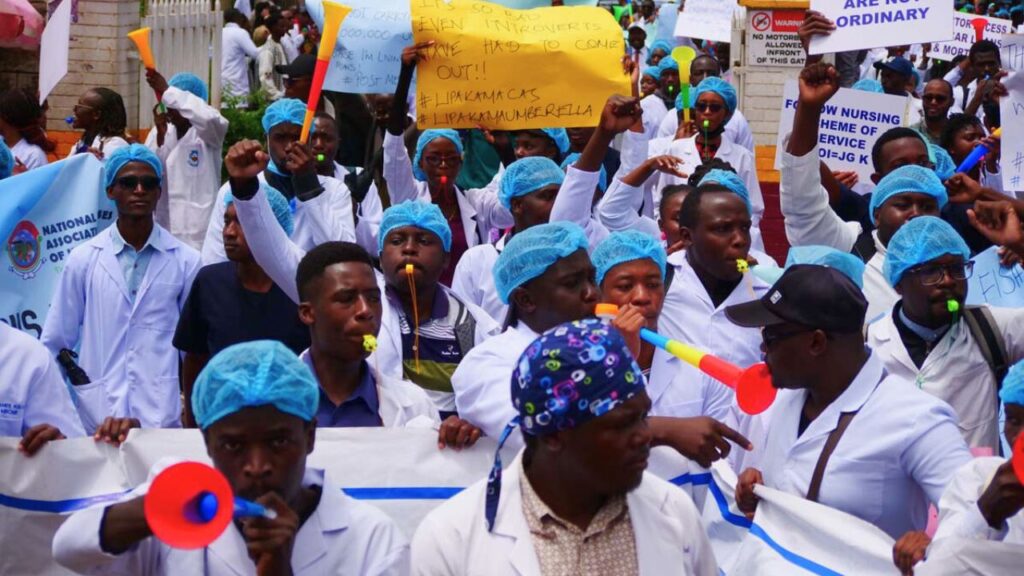Tucked away in Nairobi’s Dandora Phase 4 slum is a shanty that Lucy Wanjiru, 28, calls home, one of the many tiny, poorly lit structures built with scraps of corrugated iron sheets and metal. At Lucy’s doorstep is a vegetable garden littered with dozens of mostly empty jerricans that can find no storage space in her small room. To the side is a large pumpkin plant. A pile of old croc shoes that she uses as cooking fuel sits beside the three stones on which Lucy sets her pot to cook the family meals.
Just nearby is a shared pit latrine; in place of a door is a piece of sack billowing in the wind.
“I do not have a special toilet like the rich people. I use the pipe toilet,” the mother of two who earns a living washing clothes and who moved here seven years ago after getting married tells the Elephant.
A pipe toilet is a pit latrine with a pipe attached to it. When you pour water to flush, the faecal matter passes through the pipe and drains directly into the nearby Nairobi River from which Lucy draws water to grow her vegetables, do the laundry and bathe because she cannot afford to buy enough domestic water from vendors.
This is a major health risk to Lucy and her family as the river water can transmit diseases such polio, diarrhoea, dysentery, typhoid, as well as cholera, which averages 3,500 cases annually and costs Kenya about US$2.2 million. But Lucy says she has no alternative.
“I can stay thirsty for a few days but I am a woman, I need to bathe. What other choice do I have? Now I have vegetables, and the little money I get, I buy maize flour and cooking oil. I don’t have to buy paraffin, my husband brings old shoes from the Dandora dump site where he works,” says Lucy, who caught typhoid three times in 2021.
Lucy is not the only one in this situation. Here in Dandora, home to more than 140,000 Nairobi residents, clean water, sanitation and waste disposal facilities are a luxury.
Residents are forced to buy costly water from cartels that have privatised the water supply and discharge all their waste into the river they depend on for bathing, washing clothes, cleaning, and for crop and livestock farming, endangering their lives and harming the environment in the process.
Known for its crime, poverty and as the city’s main dumpsite, the Dandora slum suffers from a severe water shortage. Yet it sits on the banks of Nairobi River, a biodiversity-rich source of clean water a century ago. But explosive population growth, industrialization and lack of waste management infrastructure in Nairobi have left the river very sick.
Billions of shillings have been spent by the government and other institutions in an effort to clean up the river, revamp the city’s sewerage system and provide clean water to the city’s residents with little success; the condition of the river continues to deteriorate.
Experts say this is because the full context of the problem is ignored; slum dwellers, one of the chief drivers of river pollution, are not involved yet their participation is critical to improving the health of the river.
Sam Dindi, an environmentalist and co-founder of Mazingara Yetu, a community-based organisation, has for years been part of the Ngong River Restoration initiative under the Nairobi City Regeneration Programme (NCRP), and the restoration of the Ondiri wetland, the source of the Nairobi River.
Speaking to the Elephant, Dindi observed that Kenya is a water-scarce country where pollution and climate change have exacerbated water scarcity. “We’re losing much needed water but you cannot clean the river without addressing the source of its pollution. Slum dwellers are a major polluter and most affected.
They have no water, toilets, sewage or solid waste disposal systems and housing conditions and planning are extremely poor and hazardous. All their waste ends up polluting the river, environment and creating water scarcity.
To rehabilitate the river, we need proper urban planning, sanitation systems and recycling facilities then we’ll know this waste is going here, and this is going there. We’ll even create jobs but putting on an overall and heading to the river to remove solid waste is just a PR exercise. It’s a waste of time.”
The story of Nairobi River
Nairobi River is the main river of the Nairobi River Basin comprising Ngong, Nairobi, Mathare, Kiu, Riara and Gatharaini rivers. In Ondiri, Kikuyu, Kiambu County where the Nairobi River originates, the water is clean and clear. During a field visit in November last year, I found a man dipping his water bottle and drinking water directly from the river; he has done this since childhood.
But as the river winds downstream across the city, passing through residential areas, factories, industries, hospitals and businesses including in the Nairobi Central Business District (CBD), the industrial area and the highly populated informal settlements like Dandora, the river gathers all manner of waste that now threatens its existence.
Putting on an overall and heading to the river to remove solid waste is just a PR exercise. It’s a waste of time.”
It is here in Dandora Phase 4 where Lucy lives that the Mathare River meets and joins the Nairobi River, draining into the Athi River east of Nairobi, and eventually into the Indian Ocean as the Galana River.
The Nairobi River and all its tributaries are heavily polluted with sewage from open sewers and industrial waste that is illegally channelled by unscrupulous developers. So bad is the pollution that studies have declared the waters too toxic for any useful purpose.
Acute water shortage in Dandora
Mwaura’s shanty in Dandora is just a few metres from Nairobi River. The 72-year-old says he does not pay rent because he owns the land. He however does not have a title deed.
Mwaura was born and raised in the shanty he calls home. Yet he could be uprooted at any time; like many others in the slum, his house is built without government approval and is considered illegally constructed as the government owns the land.
For years, Mwaura has tried to install piped water without success, forcing him to buy water from vendors, kiosks and water cartels at exorbitant prices. “The river water is black and poisonous. I cannot use it but if I had 10,000 shillings, I would pay this man in the neighbourhood who lets people connect pipes from his house to their homes. But that amount is too high. I cannot afford it,” says the former watchman.
Charlie, a recently widowed father of two, considers the river too toxic, “Water is everything but I will not endanger my children. I struggle daily wondering why I have to choose between buying food, paraffin or fetching water. Life was easier when my wife was here because fetching water is a woman’s duty.”
The Nairobi River and all its tributaries are heavily polluted with sewage from open sewers and industrial waste that is illegally channelled by unscrupulous developers.
He is fortunate however not to have to pay rent since his former landlord disappeared years ago. Charlie soon erected two shanties that he rents out to feed his family but to date, he is unable to install piped water because it is too expensive, he says.
Kenya’s constitution recognises that access to adequate food, housing, reasonable standards of sanitation and clean, safe water in adequate quantities is an economic and social right for every person. Dandora’s residents, however, say these rights are just on paper.
According to UN Habitat, only 22 per cent of Nairobi’s slum dwellers have piped water. Seventy-five per cent of residents buy water from vendors, paying more for water than those living in middle or high-income areas.
In 2020, UN Human Rights reported that the price of piped water in Nairobi’s middle class neighbourhoods ranged between KSh34 and KSh53 per cubic metre (1000 litres) whereas residents of informal settlements paid between KSh10 and KSh50 for a 20-litre jerry can.
Drawing data from Nairobi City Water and Sewerage Company (NCWSC) between 1985 and 2018 and Global Human Settlement between 1975 and 2014, a recent study further highlighted inequality in water distribution, access and cost between Nairobi’s high-income and low-income areas. According to the study, slum dwellers are unlikely to receive the 1,500 litres of water every month per person recommended by World Health Organisation (WHO), unlike residents of high and middle income areas who are four or six times more likely to receive the recommended amounts.
Kenya Vision 2030 targets 100 per cent provision of safe water and access to basic sanitation services by 2030, the deadline for achieving the Sustainable Development Goals (SDGS). Yet, today, just 50 per cent of Nairobi has piped water coverage, with only 40 per cent receiving water on a 24-hour basis.
Following extended periods of drought, the government introduced water rationing in Nairobi in 2017, with residents receiving water on specific days. Some residents have access to water for only a few hours a day while others receive water at least three times a week, leaving many at the mercy of water cartels.
According to NCWSC, which is mandated to provide the city with water and sewage services, Nairobi’s water needs have grown to more than 810,000 cubic meters daily against an installed capacity of 525,600 cubic meters.
“The demand is higher than supply. We are 20 years behind,” NCWSC Managing Director Nahashon Muguna said in an interview.
No waste facilities in Dandora
Mwaura’s pit latrine collapsed just a few days after the outbreak of the COVID-19 pandemic in Kenya. Now, every time he or his family needs to use the toilet, he must ask permission from his neighbour. “It sank to the ground but nobody was injured. This was my first toilet, a bit old but it was still my toilet and never drained to the river like the rest in the area,” Mwaura said.
The father of four says that many years ago he and his family used to practice open defecation because at the time, “there were bushes and the area wasn’t as populated as now”. A field visit to Dandora is an obstacle race over rocks, logs, open trenches filled with wastewater, human waste and heaps of garbage, all of which finally ends up in the Nairobi River.
The makeshift structures along the banks of the Nairobi River, including homes and businesses, all have pipe toilets that discharge waste directly into the river. Residents without pipe toilets—or who are not connected to sewer lines because of lack of money—confided that when their toilets are full, they empty them by scooping the waste with buckets and discharging it into the river.
Traders in Dandora, including those selling food, go about their business amidst the stench of sewage flowing through broken sewer lines, narrow open trenches, and overflowing manholes, all leading to the river.
Nairobi’s water needs have grown to more than 810,000 cubic meters daily against an installed capacity of 525,600 cubic meters.
“I’ve had typhoid several times this year [2021], but it wasn’t this food, it was from drinking that water,” Esther Muthoni, a resident told the Elephant as she pointed at the water pipes in the mess of sewage. The World Health Organisation warns that wastewater can seep into the water supply through damaged pipes making it undrinkable.
“Everything is a risk here. But we’re used to the filth,” Muthoni said as she stuffed boiled potatoes in chicken necks to make kuku chipo ya kuchemsha for her clients.
People can be seen defecating in the open areas and near or in the river even as others wash themselves or clean their clothes, oblivious of the danger they pose to those using the water. The situation is no different in Korogocho, Kamukunji (Shauri Moyo) and other areas near Gikomba market.
According to Unicef, Kenya is one of 26 countries in the world that are responsible for 90 per cent of open defecation with an estimated five million Kenyans practising open defecation. The practice costs the economy KSh8 billion every year with approximately 19,500 Kenyans, including 17,100 children under the age of five years dying annually from diarrhoea according to the Ministry of Health Environmental Sanitation and Hygiene Strategic Framework (KeSSF) 2016-2020 report.
Kenya plans to eliminate open defecation by 2025. To do this, some 1.2 million latrines—at a cost of KSh1,530 each—are required. Overall, the ministry says, Kenya loses an estimated KSh27 billion (US$365 million) annually due to poor sanitation, about 1 per cent of the national GDP.
In another area of Dandora, David, barely two years old, is playing in the open trenches outside his family’s single room home. His sickly and heavily pregnant mother rushes to pick him up. Three days earlier, David had been taken to hospital at night following three days of diarrhoea, a leading cause of death and disability in Kenya. “I am tired of going to the hospital. But what do I do? He wants to play but there’s no space. It’s worse when I have to go work,” the mother of four lamented.
In Kenya in 2018, 1,499,146 cases of diarrhoea were reported among children under five years, with Nairobi accounting for 136,028 cases. 25.6 per cent of children living in the informal settlement had diarrhoea.
Kenya is one of 26 countries in the world that are responsible for 90 per cent of open defecation with an estimated five million Kenyans practising open defecation.
Residents of Dandora told the Elephant that they have nowhere else to take their waste and the river made sense as waste would “flow downstream” or “get washed away by the rain”. Some thought the river was just an open sewer.
With funding from the Africa Development Bank (AfDB), the Nairobi Sewerage Improvement Project, which is part of the larger Nairobi River Basin Rehabilitation and Restoration Programme, has developed wastewater facilities and increased the city’s sewage coverage from 40 to 48 per cent.
The AfDB says that infrastructure has not kept pace with the growing population, industrialization and urbanisation, which has led to heavy pollution of Nairobi’s rivers, including Mathare, Ngong, Athi and Kiu, the main source of water supply for the city. Domestic and industrial waste is discharged directly into the rivers without being treated, which has an adverse impact on the river ecology.
Currently, Kenya’s urban areas host 12 million people and the number is expected to triple to 40 million by 2050. And as Nairobi grows, the World Bank says, more poor urban dwellers are pushed into low-income settlements, where there is little or no water or sanitation.
Residents of Dandora told the Elephant that they have nowhere else to take their waste and the river made sense as waste would “flow downstream” or “get washed away by the rain”.
According to the Nairobi County Assembly, 60 per cent of Nairobi’s 4,397,073 residents live in slums and informal settlements and occupy only 6 per cent of Nairobi’s total land area.
“It’s difficult to provide social amenities at a pace that matches the population growth hence facilities like water and sewerage have been overstretched,” the Nairobi County Government said in its 21/22 development plan.
Kenya’s capital Nairobi generates 525 million litres of wastewater daily, less than 200 million litres of which are treated. The city’s main treatment plants, Dandora Estate Sewage Treatment Works (DSTW), which was built in 1975, and Kariobangi Sewerage Treatment Plant, which was built in 1960 and started operating in 1963, have been overwhelmed. “The effluent from the treatment plant, which is discharged into Nairobi River for reuse, currently does not meet required quality standards due to overloading,” the Dandora treatment plant reports on its website.
The city also generates an estimated 2,400 tonnes of solid waste daily yet only 45 per cent is recycled, reused or transformed into a form which can yield an economic or ecological benefit. The rest finds its way into waterways like the Nairobi River, which provides a livelihood for many residents as a source of water for farming, domestic use, industrial use, and at recreation facilities such as the Dandora Waterfall and the Fourteen Falls in Thika.
Polluting companies
Although residents living along the banks depend on the health of Nairobi River, factories and drainage have heavily polluted its waters for decades. Household and human waste, pharmaceutical and industrial waste, chemicals and heavy metals are among the pollutants that are discharged into the Nairobi River on a daily basis. Since 2019, 21 dead bodies—16 infants and 5 adults dumped in the river to rot—have been retrieved so far.
The Cabinet Secretary for the Ministry of Environment and Forestry, Keriako Tobiko, has directed that individuals, companies and public institutions discharging raw waste into Nairobi River be charged and prosecuted. The Technical Director of Nairobi Water and Sewage Ltd was arrested after the CS found sewer lines discharging waste to the river.
In mid-2020, the National Environment Management Authority identified 148 polluters who were to be arraigned in court. Companies and factories, including Apex Coating East Africa, Kamongo Waste Recycling Company and Associated Battery Manufacturers (ABM), have been shut down by the National Environment Management Authority (NEMA) for discharging untreated effluent into the river.
Since 2019, 21 dead bodies—16 infants and 5 adults dumped in the river to rot—have been retrieved so far.
During the “Ng’arisha Jiji” programme, former Nairobi Governor Mike Mbuvi Sonko also directed the closure of 25 companies and hospitals for discharging raw sewage and aborted babies into the river. According to environmentalist Sam Dindi, sewage trucks empty waste into the river instead of taking it to designated waste disposal sites.
Toxins and diseases
Many Nairobi residents are not aware that they could be eating vegetables that are killing them, or are using non-woven shopping bags scavenged from dumpsites like Dandora and washed in the Nairobi River.
Scientific studies show that lead and cadmium levels are 13,500 ppm (parts per million) and 1,058 ppm respectively along the riparian areas where farmers have channelled the river water into their farms, including in the Dandora dumpsite area. They rear animals, grow maize, arrowroots, Napier grass and vegetables that are later sold in the area, in estates nearby and in markets like Ruai, Muthurwa and Gikomba.
“I see the dirt as fertiliser and you can see vegetables are green and healthy,” says Willy, a farmer in Dandora Phase 4 who uses the river water. He says he made a killing last year selling traditional vegetables and even managed to pay college fees for his young cousin. While Willy moves from door to door in Dandora selling his vegetables, farmers in the neighbouring Lucky Summer Estate have established their stalls just outside the estate gates.
According to the environment CS, the river pollution and consumption of food produced with polluted water undermines the realisation of universal health and food security, which are among the country’s Big Four Agenda.
The pollution creates clean water scarcity, degrades the environment, and exposes people to heavy metal poisoning. The bacteria, sewage, chemicals and plastics suck oxygen from water supplies and transform water into poison for humans and ecosystems. Lab analyses of water collected at different points in the river showed that the amounts of lead, copper, chromium, zinc and manganese were greater than the limits set by the WHO and NEMA.
High manganese concentrations can cause liver damage, neurotoxicity, chronic respiratory inflammation and birth defects such as cleft lip, heart defects, imperforate anus and deafness, in addition to causing aggressive behaviour and libido disturbances. “The concentration of lead, one of the most insidious of all environmental hazards, was also above the NEMA limit of 0.01 mg/L for effluent discharge into the environment in all the sampling points,” the findings say.
Antimicrobials in the river have driven the emergence of antimicrobial resistance (AMR) where bacteria, viruses, fungi and parasites have built resistance to the drugs used for treatment of diseases.
Efforts and solutions
The first attempt at rehabilitation and restoration of the Nairobi River Basin took place between 1999 and 2001, in collaboration with the United Nations Environment Programme (UNEP). The second ran from 2001 to 2003 while the third was between 2004 and 2008.
In 2017, the fourth attempt kicked off with the aim of improving Nairobi city water, sanitation facilities, waste management, and roads and housing, especially in the slums and informal settlements. However, these initiatives have had very little success and the situation is deteriorating by the day.
Lack of community engagement and participation has contributed to the limited success, according to Josephat Karomi, Chairman of Kamukunji Environment Conservation Champions (KECC), a community-based group that turned the Kamukunji grounds on the banks of the Nairobi River from a dumpsite into a clean environment.
Many Nairobi residents are not aware that they could be eating vegetables that are killing them.
“Often, issues are discussed in closed offices and riparian communities are overlooked,” Karomi said. A multi-agency team involving residents, national and county governments, the private sector, NGOs, community groups, and community leaders would combat the crisis however, he said. Karomi believes that by forging partnerships, residents can create wealth from collecting, sorting and selling waste to recyclers as much of the waste discharged into the river could be recycled.
According to Sam Dindi, to accommodate the large number of households living near the river without toilets and sanitation facilities, the government should build public toilets and facilities for washing clothes, with the grey water directed to sewer lines. “This will give the clean-ups a meaning,” he said.
Wastewater can generate wealth as nitrogen, potassium and phosphorus are recovered as fertiliser and treated wastewater is used for agriculture.
Experts have attributed the stalling of the renovation and reclamation of Nairobi River to lack of funds and political will. However, in some areas like Kibera, through which the Ngong River passes, the regeneration project has shown positive signs. Fifteen community ablution blocks have been built and new sewer lines have been laid, with old lines being rehabilitated.
The Dandora Sewage plant is getting a facelift under the KSh1.3 billion Nairobi Water Project. The construction of seven ponds of 20,000 cubic metres capacity each at a cost of KShI billion and the erection of a perimeter wall on the 4,000 acres of land at a cost of KSh300 million are underway.
The World Bank has also provided sustainable access to sanitation and water services in selected low-income areas under the Nairobi Sanitation Project at a cost of US$4.8 million and says that more needs to be done otherwise experts say projects like the KSh82 billion Thwake Dam may turn out to be white elephant if the matter is not attended to urgently.
–
Research for article was carried out with the support of a fellowship from the Media Hack collective.








